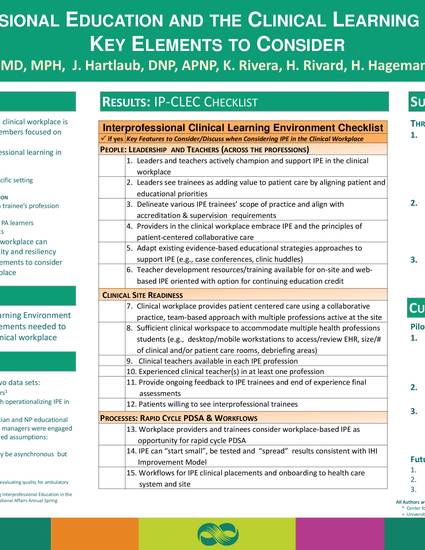
Introduction/Background
Interprofessional education (IPE) in the clinical workplace is where learners become health care team members’ focused on optimizing better patient care/outcomes. However, there may be significant barriers to effective interprofessional learning in the clinical environment ranging from facility and logistical issues (e.g., how many different learners can fit in a specific setting, scheduling of learners and providers) to differences in educational requirements by profession (e.g., medical student supervision by a physician as primary contact, overlapping expectations between MD and NP/PA learners). Yet despite the calls for IPE, there is very limited literature on the key features to consider when implementing IPE in the clinical workplace. When medical student and resident training moved to the ambulatory settings, key features associated with quality educational programs were identified and disseminated. We sought to address this gap in clinical workplace IPE.
Hypothesis/Aim Statement
To create an Interprofessional Clinical Learning Environment Checklist (IP-CLEC).
Methods
The IP-CLEC was designed by combining ambulatory-based clinical site quality indicators[1] and recently identified key features associated with operationalizing IPE in the clinical workplace.[2] An interprofessional team composed of physician and PA/NP educational leaders, educators, student education and project managers were engaged to review the checklist and revise.
Results
The IP-CLEC key features are centered in three domains: People, Facilities, and Processes.
The “People” domain highlight the need for strong and visible IPE support from clinical and education leaders, clinical teachers across the professions and providers. These individuals must see IPE as “value added” to the clinical mission and recognize the time/changes in clinical operations. The “Facilities” domain emphasizes elements associated with clinical site and provider readiness for IPE. Clinical sites must be patient centered, team oriented workplaces to model appropriate IPE behaviors and have sufficient clinical workspace for trainees. The final domain focuses on “Processes” including seeing workplace based IPE as an opportunity for rapid cycle PDSA and use of workflows for IPE clinical placements and trainee on-boarding.
Conclusions
An IP-CLEC checklist provides a trigger for discussion/planning amongst clinical/education leaders, teachers and providers. Its emphasis on leadership features - ability to see IPE as value-added to our clinical mission- provides a shared purpose and language when considering/implementing IPE clinical learning environment.
[1] Bowen JL, Stearns JA, Dohner C, Blackman J, Simpson D. Defining and evaluating quality for ambulatory care educational programs. Acad Med. 1997 Jun 1;72(6):506-10.
[2] Hageman H, Huggett KN, Simpson D, et al. 12 Tips for Operationalizing Interprofessional Education in the Clinical Workplace. Findings from the AAMC Regional Group on Educational Affairs Annual Spring Meetings 2016. [Manuscript in preparation].
Simpson D, Brill J, Hartlaub J, Rivera K, Rivard H, Hageman H, Huggett KN. Interprofessional Education and the Clinical Learning Environment: Key Elements to Consider. AIAMC Annual Meeting. March 30– April 1, 2017. Amelia Island, FL.

Aurora Sinai Medical Center
Medical Student Education
Family Medicine
Washington University Medical Center
University of Vermont Larner College of Medicine